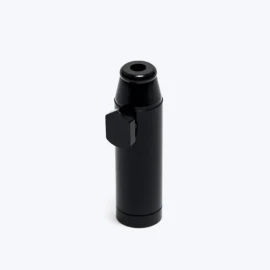Crazy Zkittles Autoflowering 10 plus 4 Pack
95,00 €
Quick Spec Snapshot
• Genetics: Zkittlez lineage (Grape Ape x Grapefruit) crossed with cannabis ruderalis
• Pack: 10 + 4 promotional seeds (feminized)
• Flowering time: ~8–10 weeks from seed
• THC: 19% reported (modern autos range 20–26%)
• CBD: Low (strain-typical)
• Ratio: 80% indica / 20% sativa
• Indoor yield: Up to 600 g/m²
• Outdoor yield: 60–120 g/plant (90 g average)
• Height: Compact — ideal for small grow spaces
• Difficulty: Easy — beginner-friendly
Product Overview
Crazy Zkittles Autoflowering delivers the beloved candy-sweet flavor profile of classic Zkittlez genetics with the convenience and speed of modern autoflowering technology. This indica-dominant strain combines the fruity terpene expressions of Grape Ape and Grapefruit parentage with ruderalis genetics to create a fast-finishing, beginner-friendly variety that thrives in compact growing spaces.
The 80/20 indica-to-sativa ratio provides deeply relaxing effects with a gentle mood uplift, making this strain ideal for evening use and stress relief. With its forgiving genetics and reliable 10-week seed-to-harvest timeline, Crazy Zkittles represents an excellent choice for first-time growers and experienced cultivators seeking quick turnarounds and consistent yields.
This promotional pack includes 14 feminized seeds total, allowing for multiple grows or sharing with fellow enthusiasts while ensuring reliable female plant production.
What’s Inside This Pack
• 14 feminized seeds: 10 guaranteed + 4 bonus seeds
• Dense indica phenotypes: Compact, resinous buds with pronounced trichome coverage
• Fruity terpene expression: Candy-sweet aroma with grape and grapefruit undertones
• Consistent genetics: Reliable autoflowering traits across phenotypes
• High germination rates: Fresh, properly stored seeds for optimal viability
Expected phenotypes display the characteristic dense bud structure of indica-dominant genetics with vibrant terpene production. Some plants may express deeper grape notes while others emphasize the citrusy grapefruit aspects of the lineage.
Grow-at-a-Glance
| Aspect | Specification |
|---|---|
| Seed-to-harvest | ~10 weeks |
| Best use | Indoor tents, small outdoor, balconies, stealth |
| Training | LST recommended; avoid heavy topping |
| Pot size | Indoor: 7–11L; Outdoor: 15–20L |
| Light schedule | 18/6 or 20/4 (24/0 acceptable) |
| Soil pH | 6.0–6.8 |
| Hydro pH | 5.5–6.2 |
Complete Growing Guide
Germination & Seedling Stage (Days 0–14)
Begin germination using the paper towel method or direct sowing in pre-warmed, moist growing medium. Maintain temperatures between 20–25°C (68–77°F) for optimal germination rates. Once cotyledons emerge, provide gentle lighting at 200–300 µmol/m²/s using LED or fluorescent sources.
Keep humidity high using a propagation dome while avoiding overwatering, which can lead to damping-off. Transplant seedlings after developing 2–3 true nodes, or plant directly in final containers to minimize transplant shock that can delay autoflowering varieties.
Early Vegetative Phase (Weeks 2–4)
Maintain environmental conditions at 20–26°C (68–79°F) with relative humidity between 55–65%. Increase light intensity to 400–600 µmol/m²/s on an 18/6 or 20/4 schedule to prepare plants for robust flowering development.
Begin feeding with mild vegetative nutrients once plants establish 3+ nodes. Target EC levels of 0.4–0.6 (200–400 ppm) during this sensitive growth period. Start low-stress training from week 2 using gentle tie-downs and LST techniques while avoiding aggressive topping that can stress autoflowering genetics.
Flowering Phase (Weeks 4–10)
Transition environmental conditions to support heavy bud development with temperatures of 18–26°C (64–79°F). Gradually reduce humidity to 40–50% during late flowering to preserve terpene profiles and prevent mold issues.
Switch to bloom-focused nutrients with higher phosphorus and potassium ratios:
– Early bloom: 1.2–1.6 EC (600–900 ppm)
– Mid bloom: 1.6–2.0 EC (900–1200 ppm)
– Late bloom: 1.6–1.8 EC (900–1100 ppm)
Continue light LST and consider minimal defoliation only if necessary for light penetration. Allow slight drying between waterings to encourage robust root development while maintaining consistent moisture levels.
Harvest Timing & Indicators
Monitor trichome development using a jeweler’s loupe or microscope. Harvest when trichomes appear mostly cloudy with 10–20% amber coloration for the characteristic indica relaxation effects. Most pistils should have darkened and retracted by this stage.
Begin flushing with plain, pH-balanced water during the final 7–10 days to improve flavor and smoothness. Typical harvest occurs 8–10 weeks from seed, though some phenotypes may finish slightly earlier or later.
Growing Medium & Container Recommendations
Soil & Amendments
Select light, well-draining soil mixes containing perlite for optimal root aeration. Coco coir or soilless blends provide excellent growth control for experienced growers. Enhance soil with organic amendments including:
– Worm castings for slow-release nutrients
– Kelp meal for trace minerals and growth hormones
– Mycorrhizae inoculant at transplant for enhanced root health
– Dolomite lime for pH buffering in organic grows
Container Selection
Use air pots or fabric containers to promote healthy root development. Indoor grows perform best in 7–11 liter containers, while outdoor cultivation benefits from 15–20 liter pots for maximum yield potential. Larger containers generally produce bigger plants with higher yields.
Store unused seeds in cool, dark, dry conditions. Refrigeration at approximately 4°C in original packaging maintains viability for extended periods.
Weekly Feeding Schedule
Weeks 1–2: Minimal seedling nutrients – focus on root establishment
Weeks 3–4: Light vegetative feeding with nitrogen emphasis
Weeks 5–7: Transition to bloom nutrients with increased P&K
Weeks 8–10: Peak flowering nutrition followed by flush if trichomes indicate readiness
Monitor plant response and adjust concentrations based on leaf color and growth patterns. Use the EC/ppm guidelines provided while accounting for environmental factors and phenotype variations.
Training Techniques for Autoflowers
Recommended Methods
Low Stress Training (LST): Begin gentle branch positioning from week 2 to create even canopy development. Use soft ties to bend branches horizontally, exposing lower bud sites to direct light.
Light Defoliation: Remove only fan leaves blocking bud sites during early flowering. Avoid aggressive defoliation that can stress plants and reduce yields.
Screen of Green (SCROG): Advanced technique using horizontal screens to train branches. Plan for shorter growth cycles compared to photoperiod varieties.
Techniques to Avoid
Heavy topping or super cropping early in development can significantly delay autoflowering plants. If attempting topping, limit to single cuts at 3–4 nodes and only with extensive autoflower experience.
Environmental Optimization
Climate Control
Maintain consistent temperatures throughout the grow cycle, avoiding extreme fluctuations that stress autoflowering genetics. Provide adequate air circulation using oscillating fans while avoiding direct airflow on young plants.
Monitor humidity levels closely, especially during flowering when dense buds become susceptible to mold and rot. Use dehumidifiers in high-humidity environments and ensure proper ventilation.
Lighting Considerations
Autoflowers respond well to consistent light schedules without requiring darkness periods for flowering initiation. Many growers prefer 18/6 or 20/4 schedules for energy efficiency while maintaining robust growth.
Adjust light intensity based on growth stage, starting conservatively with seedlings and gradually increasing to flowering-level intensities around 600–800 µmol/m²/s during peak bud development.
Pest & Disease Prevention
Integrated Pest Management
Implement preventative measures including clean growing environments, sterilized tools, and quarantine procedures for new plants. Monitor regularly using magnification and sticky traps for early detection.
Common issues include spider mites, fungus gnats, and powdery mildew. Address problems quickly using appropriate treatments:
– Beneficial insects: Predatory mites for spider mite control
– Biological controls: BTi (Bacillus thuringiensis israelensis) for fungus gnat larvae
– Foliar treatments: Neem oil or potassium bicarbonate (avoid late flowering applications)
Regional Considerations
Hot Climates: Plant early to avoid extreme summer heat. Use shade cloth during peak temperatures and ensure adequate ventilation.
Cool Climates: Select the sunniest growing locations and consider greenhouse protection. Stagger plantings for continuous harvests.
Humid Regions: Prioritize airflow and humidity control. Choose mold-resistant genetics and maintain lower humidity during flowering.
Flavor Profile & Effects
Aroma & Taste
Crazy Zkittles produces distinctive candy-sweet aromas dominated by fruity notes reminiscent of grape and grapefruit candy. The terpene profile typically includes limonene for citrus brightness, myrcene for body relaxation, and caryophyllene for spicy undertones.
Properly cured buds deliver smooth, flavorful smoke with pronounced fruit flavors on the inhale and sweet, lingering aftertastes. The Zkittlez genetics shine through in the complex terpene expression that made the original photoperiod version famous.
Effects & Usage
The 80% indica dominance provides deeply relaxing physical effects complemented by gentle cerebral uplift from the 20% sativa influence. Users typically experience:
– Deep body relaxation and tension relief
– Mild euphoria and mood enhancement
– Increased appetite and stress reduction
– Calm, peaceful mental state ideal for evening use
This strain suits consumers seeking relaxation without overwhelming sedation, making it appropriate for stress relief, appetite stimulation, and evening unwinding.
Indoor vs Outdoor Performance
Indoor Cultivation
Controlled indoor environments maximize yield potential up to 600 g/m² under optimal conditions. Benefits include:
– Precise environmental control for consistent results
– Protection from weather and pests
– Multiple harvests per year regardless of season
– Enhanced terpene preservation through climate control
Focus on proper ventilation, consistent feeding, and adequate lighting for best results.
Outdoor Growing
Outdoor plants typically yield 60–120 grams per plant with 90-gram averages in favorable conditions. Advantages include:
– Natural sunlight for robust growth
– Reduced equipment and energy costs
– Larger root zones in ground plantings
– Multiple seasonal harvests in warm climates
Select sunny, protected locations with good soil drainage. Consider container growing for mobility and root zone control.
Post-Harvest Processing
Drying
Hang trimmed branches in dark environments maintaining 18–21°C (64–70°F) with 45–55% relative humidity. Drying typically requires 7–14 days until stems snap cleanly rather than bending. Avoid over-drying which can degrade terpene content.
Trimming
Remove fan leaves and trim sugar leaves close to buds for smooth smoke quality. Wet trimming immediately after harvest or dry trimming after initial drying both produce excellent results based on grower preference and environmental conditions.
Curing
Place dried buds in airtight glass jars maintaining 60–62% relative humidity. Burp jars daily for the first week, then weekly thereafter. Optimal curing extends 3–8 weeks, developing full terpene complexity and smoothness.
Store cured cannabis in cool, dark locations using humidity control packs for long-term preservation.
Troubleshooting Common Issues
Seedling Problems
Damping-off: Prevent with sterile growing medium, proper drainage, and adequate airflow. Avoid overwatering young plants.
Slow germination: Ensure consistent temperature (20–25°C) and moisture without waterlogging seeds.
Growth Issues
Stunted development: Check pH levels, root binding in small containers, light intensity, and nutrient concentrations. Autoflowers are sensitive to overfeeding.
Nutrient deficiencies: Yellow leaves may indicate nitrogen deficiency in vegetative growth or natural senescence during late flowering. Adjust feeding accordingly.
Flowering Problems
Reduced terpene production: Avoid high temperatures during late flowering and drying. Maintain proper humidity and gentle environmental conditions.
Premature harvesting: Monitor trichomes rather than seed bank timelines. Some phenotypes may require additional time for full maturation.
Frequently Asked Questions
Are these seeds feminized?
Yes, all 14 seeds (10 + 4 bonus) are feminized, ensuring female plant production without male pollination concerns.
Can autoflowers be cloned?
Cloning autoflowers is not recommended as clones inherit the mother plant’s age and will flower immediately with poor yields.
How many outdoor harvests are possible?
Warm climate growers can achieve 2–3 staggered plantings per season, while cooler regions typically allow one main harvest.
What’s the difference between this and photoperiod Zkittlez?
Autoflowering versions finish in ~10 weeks regardless of light schedule, while photoperiods require several months with specific lighting changes but may produce larger yields.
How should unused seeds be stored?
Store in original packaging in cool, dry, dark conditions. Refrigeration at 4°C maintains viability for years.
Legal Considerations
Cannabis cultivation laws vary significantly by jurisdiction. Research local regulations regarding possession, cultivation, and seed purchase before proceeding. This product is intended for legal cultivation in compliance with applicable laws.
Keep seeds secure and away from minors and pets. Handle responsibly according to local guidelines and safety recommendations.
Ideal Grower Profile
Crazy Zkittles Autoflowering suits:
– Beginning growers seeking forgiving, fast-finishing genetics
– Small-space cultivators requiring compact, stealth-friendly plants
– Flavor enthusiasts wanting candy-sweet terpene profiles
– Efficiency-focused growers needing quick turnarounds and reliable yields
– Multi-plant growers planning sequential harvests or sharing seeds
The combination of reliable genetics, beginner-friendly growth characteristics, and premium Zkittlez flavor makes this strain an excellent choice for diverse growing situations and experience levels.
Related Products
Frequently Asked Questions
Everything You Need to Know















